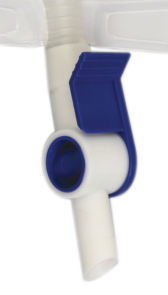Single reversal valve
Single reversal valve used in “day use” devices (used on multiple patients through a day without
reprocessing between patients) are intended to reduce the potential for cross-contamination between
patients resulting from the backflow of patient fluids. Single reversal valve are typically designed to
withstand high levels of backpressure before failure; however, they may not be explicitly designed as a
means of infection control as used in medical device applications.
Methods: Five different medical grade one-way valves were placed in low pressure configurations.
Following flushing in the intended direction of flow, bacteriophage, bacteria, or dye was placed
“patient” side for 24 hours. The upstream “device” side of the valves was then evaluated for microbial
growth or presence of visible dye.
Results: Leakage (i.e., backflow) of the microorganisms occurred with a variety of one-way valve designs
across a range of fluid properties tested.
Conclusion: This study describes testing of the one-way valves (component-level testing) for the
potential of cross-contamination. Although “day use” medical device systems may employ numerous
other factors to prevent patient cross-contamination, this work demonstrates that one-way valves
themselves may not prevent leakage of contaminated fluid if the fluid is able to reach the upstream side
of the one-way valve.
Page 2 of 10
Introduction
There are a wide variety of reusable medical devices that are used on more than one patient, e.g.,
surgical instruments, endoscopes, etc. To prevent cross-contamination of microorganisms between
patients, reusable medical devices are reprocessed between uses, which may involve cleaning,
disinfection, and/or sterilization, in order to render the device fit for a subsequent reuse1
.
There is a subset of medical devices in which a component or components not in direct contact with a
patient would be reused on multiple patients throughout an entire day (e.g., 24 hours) without
reprocessing between patient uses. These “day use” 2-4 devices (also referred to as “24-hour use”
devices) are typically discarded after the end of the day.
Since day use devices have a component that only make indirect patient contact (e.g., tubing sets used
with various types of irrigation/fluid systems), they are typically connected to a devices that makes
direct patient contact, and are typically either 1) used on a single patient and then discarded (single
patient use) or 2) appropriately reprocessed between patient uses. Some measures are necessary to
prevent cross-contamination between patients in these types of day use devices. One design measure
often incorporated into day use devices in a one way valve which combat the risk of backflow of
potentially contaminated patient fluids.
The use of ‘day use’ devices to cut healthcare costs, and is particularly attractive when infusing
expensive drugs or when healthcare workers must limit their exposure to certain solutions (e.g.,
radioisotopes). However, there have been reports of infection outbreaks in dialysis patients where oneway valves were implicated 5-9, demonstrating that one-way valves may not prevent cross-contamination
between patients.
Currently, there are no established methods to evaluate the performance of one-way valves in terms of
infection control. The test parameters that could impact the one-way valve performance include
pressure magnitude and fluctuation, duration of use, flow rates, and fluid properties. Differing
performance of one-way valves reported in the literature is likely due to the different experimental
conditions. Previous work by Ellger and colleagues2
simulated the clinically relevant pressure and flow
parameters of an infusion system. Those authors observed a failure to prevent contamination in a test
system that monitored increasing backpressure. Notable in the results was that there was a difference
depending on the fluid used. Propofol was more likely to fail than 0.9% NaCl. Radke and colleagues3
conducted studies to show using two check valves in the system can prevent contamination in a day-use
system specific to a piggy-back IV setup. The recognition that test parameters are device system
dependent led us to develop a simplified evaluation test method which focuses on the functionality of
the one-way valve as component of a system to prevent backflow of fluids “contaminated” with
simulated pathogens (e.g., dyes, bacteria and viruses).
Order now high quality Single reversal valve/ other
medical equipments online from
Nexgen Medical at lowest prices.

